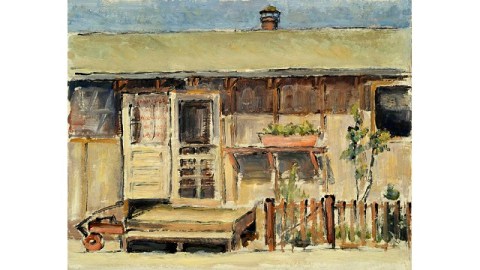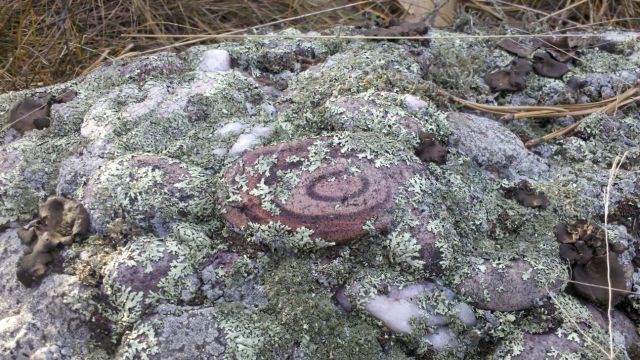How One Artist Pictured the Japanese Internment Camps—From the Inside

Last month saw the 70th anniversary of the attack on Pearl Harbor that drew the United States into World War II. Sadly, that day of infamy led to a different kind of infamy for America in the form of the Japanese Internment Camps initiated by President Franklin D. Roosevelt’s signature on Executive Order 9066 on February 19, 1942. Among the approximately 110,000 Japanese-Americans relocated and interned, Seattle area artist Kamekichi Tokita and his family found themselves moved from their home to a camp in Idaho. Signs of Home: The Paintings and Wartime Diary of Kamekichi Tokita by Barbara Johns tells the story of Tokita’s art and the diary he began on December 7th, 1941 to record for posterity the story of his experiences as a Japanese-American. To see history unfold through Tokita’s words and images is to gain a whole new perspective on that conflict and the nature of all immigrants to America who suddenly find themselves identified as the enemy.
“When Tokita immigrated in late 1919,” Johns writes, “he arrived on new shores not only as a citizen of the old world but also as a modern young man of his time.” As an Issei, a first-generation Japanese immigrant, Tokita could not legally become a U.S. citizen. (His children, however, the Nisei or second-generation Japanese-Americans born in America, became U.S. citizens by being born on U.S. soil.) Tokita found a place for himself and his family in the thriving Japanese community in the Seattle area, which could boast five Japanese language newspapers at the time. He self-identified as a “sign painter” during his Seattle days and even managed a hotel during the tough times of the Great Depression, but made his truest mark as a significant painter in the Northwest part of the U.S. Tokita demanded that his family speak only Japanese in the home to help his children hold on to their heritage, but he loved his new country and the opportunities it offered.
All that changed on December 7th, 1941. The anti-Japanese sentiment simmering for years boiled over after the attack. “The creativity and sense of adventure that brought him to the United States, the paintings that won him a place in the Northwest art community, and the honor and discipline with which he conducted his life and guided his family all seemed to have come to naught,” Johns explains. “He had lost the fruits of twenty years’ work.” Amid that shock, Tokita composed himself and began a diary, which he vowed to continue until the war ended. As Stephen H. Sumida says in his foreword, Tokita’s beginning a diary “appears to have been an unprecedented and decisive act” considering that he was “so strict and disciplined with his words that a son, Yasuo, cannot recall ever having a direct conversation with his father.” Fortunately, Tokita opened his heart into his diary, which he never imagined would ever be published.
“My diary begins today,” Tokita writes in his first diary entry, begun the night after the attacks. “My heart is full to bursting. In a moment, we have lost all the value of our existence in this society. Not only have we lost our value, we’re unwanted. It would be better if we didn’t exist.” That initial despair (captured beautifully in the translation by Haruo Takasugi and Naomi Kusunoki-Martin) gives way over time to steely resolve. After remarking that the Nisei will gain strength through this test, Tokita’s thoughts turn to the Issei: “The war presents a great opportunity for the younger generation to become disciplined. If they can survive this winnowing process the future will be bright.” Two thirds of the diary is written during the days between Pearl Harbor and the forced removal of Tokita and his family in May 1942 to the Minidoka Camp in Idaho where they would spend the rest of the war. Despite the disruptions, Tokita continually manages to paint verbal pictures of his experience, both in prose and poetry. In one memorable poem, Tokita compares the earth to an orange he found rotting under a cot and wonders if God would throw the rotting earth it into the garbage just as easily.
Unfortunately, only 40 of Tokita’s paintings survive, most from the years from 1930 to 1935 and only a handful from the war years, even through Tokita joked that imprisonment gave him more time for art than he had enjoyed for years. Johns, an art historian, curator, and the former chief curator of the Tacoma Art Museum, makes the most of those tantalizing glimpses in her analysis of Tokita’s art. “To painting skills grounded in Chinese tradition and broadened by Western practices [Tokita] brought the bicultural perspective of a Japanese immigrant at home in the United States,” Johns explains. Comparing Tokita’s urban landscapes to those of Edward Hopper, Johns sees “a sense of familiarity” in Tokita where Hopper depicts “psychological isolation.” Fascinatingly, Tokita synthesized Eastern and Western influences in his art. He saw similarities in the work of 19th century French artist Cezanne and 15th century Chinese artist Sesshu that helped him shape his own vision. “I am trying to paint the basic truths and realities of Nature through simple, rhythmic, expressive line,” Tokita claimed. Even in the internment camp, Tokita could see these “basic truths” in the prison barracks he and his family called their home for three years (shown above). Reading Tokita’s words and seeing these images, you cannot come away without a profound respect for his artistic integrity as much as his strength of character.
Kamekichi Tokita died in 1948 after a battle with diabetes. He was only 51 years old, a footnote in art history and just another name lost in the mass misery of the war years. Signs of Home: The Paintings and Wartime Diary of Kamekichi Tokita restores Tokita the artist and man to his rightful place. Barbara Johns picks the perfect face and voice in Tokita to tell the story of the Japanese internment to create a vivid story in pictures and words. I highly recommend anyone interested in this story to look at the Tokita family’s photo album (online as part of the Tokita papers at the Smithsonian’s Archives of American Art). This was a family man who loved his family in his own way and dreamed big for his children—the very definition of the American dream. Before we label any of our own citizens as enemies from within, we should think first of the story of Kamekichi Tokita how a “hyphenated American” is still an American.
[Image:Kamekichi Tokita. Title unknown(Minidoka barracks 38-8-E-F), ca. 1943-45. Oil on Masonite, 11 x 14 in. Collection of Yasuo G. Tokita.]
[Many thanks to the University of Washington Press for providing me with the image above and a review copy of Signs of Home: The Paintings and Wartime Diary of Kamekichi Tokita by Barbara Johns.]





